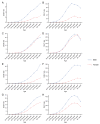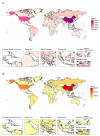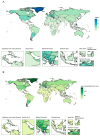The Global, Regional and National Burden of Pancreatic Cancer Attributable to Smoking, 1990 to 2019: A Systematic Analysis from the Global Burden of Disease Study 2019
- PMID: 36674311
- PMCID: PMC9859604
- DOI: 10.3390/ijerph20021552
The Global, Regional and National Burden of Pancreatic Cancer Attributable to Smoking, 1990 to 2019: A Systematic Analysis from the Global Burden of Disease Study 2019
Abstract
Objective: Pancreatic cancer poses a serious medical problem worldwide. Studies have reported the relationship between smoking and cancer. This study aimed to evaluate the burden of pancreatic cancer attributable to smoking and its global, regional and national trends, patterns and alterations from 1990 to 2019.
Methods: Data were extracted from the Global Health Data Exchange query tool, including deaths, disability-adjusted life-years (DALYs) and age-standardized rates (ASRs). Measures were stratified by sex, age, region, country/territory and sociodemographic index (SDI). We used Joinpoint regression to determine the secular trend of ASRs by calculating the average annual percentage change (AAPC).
Results: In 2019, smoking risk-related deaths and DALYs accounted for 21.3% and 21.1% of global pancreatic cancer, respectively. There were 113,384 (95% UI 98,830 to 128,466) deaths of smoking-attributable pancreatic cancer worldwide in 2019, of which 64.1% were in males. The disease burden was higher in males than in females. High-income regions or large population regions had the higher disease burden. East Asia carried the highest number of smoking-attributable pancreatic cancer deaths and DALYs. The Caribbean had the fastest increasing rate (AAPC = 3.849, 95% CI 3.310 to 4.391) of age-standardized death rate over the past 30 years. In 2019, China had the highest number of deaths, which was followed by the USA and Japan. There was a trend of increasing ASDR along with increases in SDI.
Conclusion: Variations existed in the smoking risk-related pancreatic cancer burden among different sexes, age groups, regions and countries/territories. The burden of smoking-attributable pancreatic cancer should be considered an important health issue. Future strategies should include comprehensive policies to control tobacco use.
Keywords: death; disability-adjusted life-year; pancreatic cancer; risk factor; smoking; tobacco.
Conflict of interest statement
The authors declare that they have no conflict of interest.
Figures







Similar articles
-
Gender Difference in the Trend and Forecast Analysis of Changes in the Burden of Disease of Pancreatic Cancer Attributable to Smoking in China, 1990-2021.Cancer Control. 2025 Jan-Dec;32:10732748251341521. doi: 10.1177/10732748251341521. Epub 2025 May 10. Cancer Control. 2025. PMID: 40347157 Free PMC article.
-
Global burden of prostate cancer attributable to smoking among males in 204 countries and territories, 1990-2019.BMC Cancer. 2023 Jan 26;23(1):92. doi: 10.1186/s12885-023-10552-8. BMC Cancer. 2023. PMID: 36703189 Free PMC article.
-
Global, regional, and national burdens of early onset pancreatic cancer in adolescents and adults aged 15-49 years from 1990 to 2019 based on the Global Burden of Disease Study 2019: a cross-sectional study.Int J Surg. 2024 Apr 1;110(4):1929-1940. doi: 10.1097/JS9.0000000000001054. Int J Surg. 2024. PMID: 38215264 Free PMC article.
-
The Global, Regional, and National Burden of Adult Lip, Oral, and Pharyngeal Cancer in 204 Countries and Territories: A Systematic Analysis for the Global Burden of Disease Study 2019.JAMA Oncol. 2023 Oct 1;9(10):1401-1416. doi: 10.1001/jamaoncol.2023.2960. JAMA Oncol. 2023. PMID: 37676656 Free PMC article.
-
Global, regional, and national burdens of pancreatic cancer attributable to smoking from 1990 to 2021 and the projections to 2035:a systematic analysis from the global burden of disease study 2021.Front Oncol. 2025 May 30;15:1547029. doi: 10.3389/fonc.2025.1547029. eCollection 2025. Front Oncol. 2025. PMID: 40519307 Free PMC article.
Cited by
-
Temporal trends of migraine and tension-type headache burden across the BRICS: implications from the Global Burden of Disease study 2019.Front Neurol. 2023 Dec 22;14:1307413. doi: 10.3389/fneur.2023.1307413. eCollection 2023. Front Neurol. 2023. PMID: 38187142 Free PMC article.
-
Lifestyle-Related Risk Factors for Pancreatic Ductal Adenocarcinoma: A Longitudinal Analysis of 1,120,377 Individuals From the NHISS Cohort.Cancer Med. 2025 Apr;14(7):e70848. doi: 10.1002/cam4.70848. Cancer Med. 2025. PMID: 40189877 Free PMC article.
-
Gender Difference in the Trend and Forecast Analysis of Changes in the Burden of Disease of Pancreatic Cancer Attributable to Smoking in China, 1990-2021.Cancer Control. 2025 Jan-Dec;32:10732748251341521. doi: 10.1177/10732748251341521. Epub 2025 May 10. Cancer Control. 2025. PMID: 40347157 Free PMC article.
References
-
- Deng Y., Zhao P., Zhou L., Xiang D., Hu J., Liu Y., Ruan J., Ye X., Zheng Y., Yao J., et al. Epidemiological trends of tracheal, bronchus, and lung cancer at the global, regional, and national levels: A population-based study. J. Hematol. Oncol. 2020;13:98. doi: 10.1186/s13045-020-00915-0. - DOI - PMC - PubMed
Publication types
MeSH terms
LinkOut - more resources
Full Text Sources
Medical
Miscellaneous

